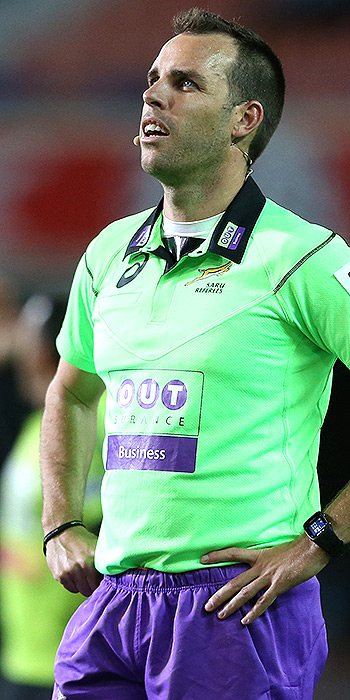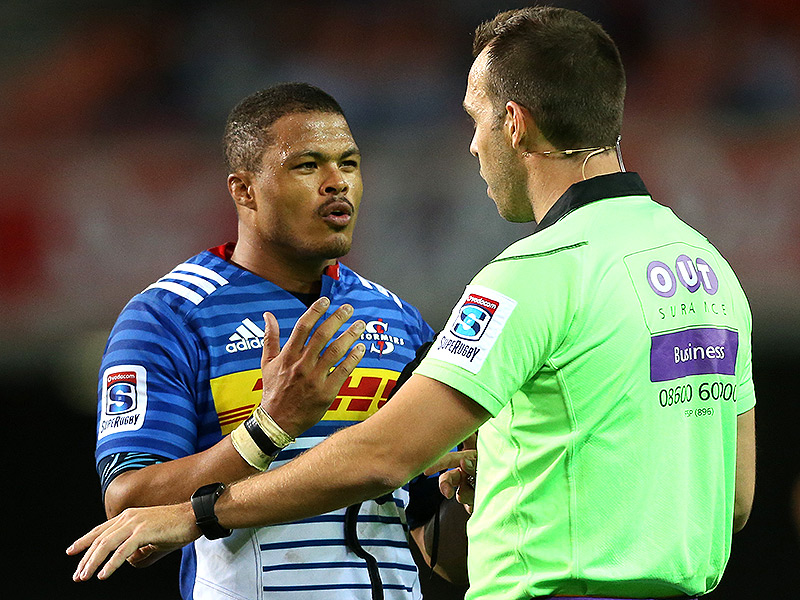Law discussion: Red air
Jean-Luc du Plessis, the Stormers flyhalf, kicks high and his left wing, Leolin Zas, chases the high ball.
Bernard Foley of the Waratahs comes forward and leaps high to catch the ball. Zas has his left foot on the ground when his left shoulder and arm make contact with Foley at roughly waist level. Foley and Zas both fall to ground, Foley going down shoulder and head first.
The referee consults the touch judge and they watch the incident in slow motion and real time. The upshot is that the referee shows Zas a red card, which means that he is sent permanently from the field.
Later, after deductions, Zas was suspended for two weeks.
There were – as there usually are – cries that this was harsh, that Zas was slipping, that Zas did not intend to do what he did do, that it was an accident.
Law first.
Law 10.4 (i) Tackling the jumper in the air
A player must not tackle nor tap, push or pull the foot or feet of an opponent jumping for the ball in a line-out or in open play.
Sanction: Penalty kick
It does not help to make semantic distinctions from the letter of the law. The intention is clear – to make the player jumping for the ball safe.
Clearly in this case Foley is not safe.
Then instruction.
At a meeting in April 2015, the Laws Representation Group (LRG) of World Rugby (previously the International Rugby Board) considered the areas of the Game where, it had been agreed that Law amendments were not required but that current Law was to be enforced by match officials including:
Challenging players in the air – Law 10.4 (i)
The options given were:
Play on – Fair challenge with both players in a realistic position to catch the ball. Even if the player(s) land(s) dangerously, play on
Penalty only – Fair challenge with wrong timing – No pulling down
Yellow card – Not a fair challenge, there is no contest and the player is pulled down landing on his back or side
Red card – Not a fair challenge, there is no contest and the player lands on his head, neck or shoulder
Look at this action and it is clear that the fourth option (Red card) best describes what has happened.
Zas did not realistically contest for possession of the ball.
Foley lands on his shoulder and head.
It is not helpful to water down the law and its intention by finding excuses for the offending player. In these matters. As in high tackles and late tackles, it is best to concentrate on the fact of the matter.
In this case Foley is in the air. He can take no evasive action when he is in the air.
Foley was in the air before Zas arrived.
Zas is not in the air. He had no chance of catching the ball before Foley did. He was in a position to take evasive action.
Zas made contact and Foley fell heavily and dangerously.
Foley had nothing to do with Zas's 'slipping'. Foley's fall had everything to do with Zas's contact.
Those are the facts.
A referee does not make the laws. His job is to administer them, and player safety is of paramount importance in a game where serious injury is possible.
A player is not obliged by law to tackle. He is allowed to tackle – but it must be within the laws of the Game.
What the referee says to the player is an excellent, succinct summary.
The decision was fair.
By Paul Dobson
@rugby365com









































